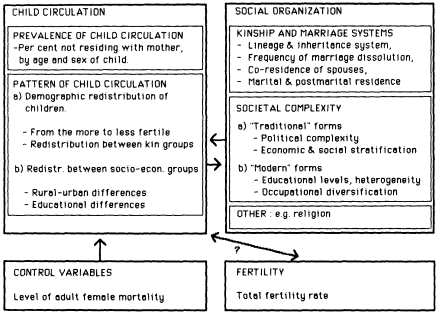Kinship and Marriage Variables
1. The form and strength of the lineage organization and inheritance systems provide an indicator of the potential interest of other lineage members in childrearing.

Figure 9.5.
Nonmaternal Residence and Social Organization
2. Women's marriage and residence patterns affect both the possibility for her children to reside with her and the desirability of having at least one raised elsewhere. We distinguish three key variables here:
3. Coresidence of spouses may constrain the possibilities for coresidence of children and their mothers since, where spouses do not live in the same household, it is not uncommon for the older children, more particularly the boys, to live with their father rather than with their mother.
4. Frequency of marriage dissolution also constrains the possibilities for mother-child coresidence, since older children of both sexes are then unlikely to stay with their mother: in patrilineal societies they are most likely to follow the husband or to go to a member of his lineage; in matrilineal ones they are more likely to go to one of their mother's kin.
5. Marital residence rules in combination with the residence patterns of women in old age, after divorce, or following widowhood determine the desirability of sending at least one child to be raised in the place the mother will later live.